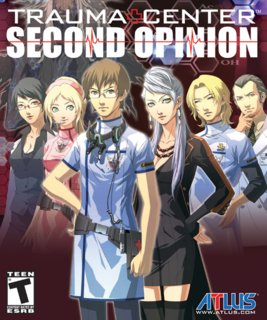You will never be able to put the remote down! Trauma Center: Second Opinion lets you put your skills to the test!
"Doctor, his tumor is growing!"
"Doctor, he's crashing!"
"Doctor! Doctor!!"
The first Trauma Center brought innovation and creativity to a handheld that's known for having both. When the Nintendo Wii – the quintessential home version of the DS – was officially unveiled in May, it was announced that Trauma Center would be operating its way to that console as well.
If you've yet to perform your first surgery, let me bring you up to speed. Trauma Center is a story-driven action/strategy game where your only goal is to save lives. That sounds simple enough, and if you were stretched out on the couch watching ER or Grey's Anatomy, the task wouldn't be that difficult. In Trauma Center, you aren't watching anything – you are the doctor. You're the one they come to when a patient is covered in broken glass. Its tiny, piercing shards must be removed one at a time with crucial steadiness.
When a patient starts having intense stomach pains, you're the one who has to cut her open, explore her insides, remove the source, and stitch her up with care for minimal scarring.
The game is brilliant in concept, and positively stunning in execution. Trauma Center: Second Opinion comes to the Wii with more than rehashed elements from the DS original.
There are games like Madden and Excite Truck that can use the Wii remote to change the control and gameplay style. Trauma Center, however, is a game that could not have existed with the last generation of game controllers.
The game assigns many motion-specific functions to your remote: scalpel, syringe, forceps, ultrasound, laser, antibiotic gel, stitches, and drain (a vacuum that reduces blood interference). Each of these are heavily dependant on the player's movement.
At the start of each operation, your first task is usually the most difficult to get exactly right: you have to cut open a patient. Try to envision how hard it must be to do this on a real person, then apply that thought to the game but not with a real scalpel, but with the Wii remote. Your arm, suspended in air, must gradually draw a line – indicated by a few points on the screen – across the body. There's a time limit, so you can't take too long. But if you go too fast you're likely to veer off course. The patient will feel additional pain, his or her vitality will drop, and you'll have to start over.
Aside from drawing a perfectly straight line, players must also keep this motion steady. Think of it as playing an instrument. If your tempo isn't consistent, the outcome won't be music to your ears – or anyone else's, least of all the patient.
The process of removing glass and tumors is a simplified version of the real thing. You clamp onto the glass or tumor using the forceps. Both the A and B buttons must be held down, reinforcing the sense that you're clamping something. Tumors may be picked up quickly and tossed aside, but glass needs to be lifted out with care. Slow and steady movements will prevent the glass from striking the patient as it's removed, which results in less pain and a higher vitality rating.
Tumors are easier to lift out, but their removal is much more involved. You first have to locate them with ultrasound (point to different parts of the body and press the A button). Tumors will only stay visible for a short time after being located. Make a small incision to reveal its true location. Drain the blood, then cut around the dotted points to separate it from the patient. Small growths may form next to the tumor -- zap those with your laser. Finally, clamp down on the tumor and remove it, clean the wound, and patch it up.
All of the described actions are done by pointing and waving the Wii remote. Many of these were found in the DS version, in which you would push down on the screen using the stylus and drag as necessary.
Second Opinion introduces a lot of cool things that are only possible on Wii. When a patient is crashing, the player must push both controller pieces (the remote and nunchuck) toward the screen for the defibrillator to make contact.
Broken bones can't simply be removed – they must be put back together. The pieces of the broken bone come in different shapes and sizes. Your goal is to grab those pieces and position them in the proper location. To do that you'll have to clamp down on the pieces and twist your wrist until each piece is lined up. Release both buttons and, if done correctly, the piece will snap into place. That part is nothing like a real operation – doctors don't have that luxury. But this is a game, and as realistic as the developers wanted to make it, they also wanted it to be fun and accessible to those of us that haven't gone to medical school.

